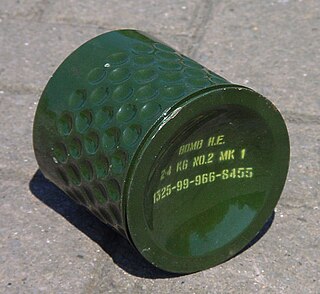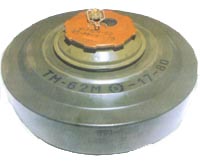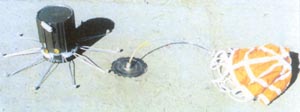
The HB 876 mine was an air dropped area denial weapon. It was used as part of the JP233 runway denial system and the 'Hades' variant of the BL755 cluster bomb. As a result of the anti-personnel mine ban it was withdrawn from British Royal Air Force service, and the last stockpiles of the mine were destroyed on 19 October 1999.

The National Development Complex (NDC) is a Pakistani defence and aerospace contractor and a division under the National Engineering and Scientific Commission (NESCOM). Founded in 1990 at the MoD, the NDC engaged in research and development in space-based missile systems and expanded its services towards developing the land-based weapons systems for the army as well as naval systems for the navy.
The TM-89 is a Russian anti-tank mine first publicly shown in 1993. The mine uses a Misznay Schardin effect warhead capable of producing a 60 mm diameter hole in 100 mm of armour. The mine is fitted with a two-channel magnetic influence fuze, and can be laid from the GMZ-3 mine layer or by the VMR-2 helicopter mine layer.
The TM-83 is a Soviet off-route anti-tank mine, first shown publicly in 1993. The mine consists of a large Misznay Schardin effect warhead and infra-red and seismic sensors.

The AT2 mine is a scatterable anti-tank mine developed by Dynamit Nobel. It can be scattered from artillery rockets or from mine laying systems, and was used by the British, German and Norwegian armed forces until the signing of the Ottawa Treaty.
The SATM mine is a Chinese copy of the AT2 scatterable anti-tank mine. It is scattered either from a mine scattering vehicle or by 122 mm Type 84 rockets which hold eight mines each. The mine functions in the same way as the AT-2 with a seismic sensor that activates the mine and a magnetic influence sensor combined with a "scraping wire" sensor to ensure optimum detonation.

TM-62 is the designation for a series of Soviet anti-tank blast mines. The mines have a central fuze and typically have a 7.5 kg explosive charge, however they vary greatly in detail. The mines can be laid manually or automatically from a mine laying machine including the PMR-1, PMR-2 wheeled towed mine layers, the GMZ tracked mine laying vehicle and the VMR-2 helicopter mine laying system.
The MPP-B "Wierzba" is a fibreglass Polish minimum metal anti-tank blast mine. The mine is similar to the Russian TM-62 series and is compatible with the same fuses. It is normally used with a MWCz-62 fuse with a clockwork arming delay, which is a copy of the Russian MVCh-62. The mine has a secondary fuse well in the base of the mine for anti-handling devices or for a command detonation device. It can also be used with a ZMN electronic combined pressure and magnetic influence fuse.
The Adrushy is an Indian glass-reinforced, plastic-cased anti-tank landmine.
The VS-SATM1 is an Italian scatterable anti-tank landmine that was produced by Valsella Meccanotecnica SpA. The mine can be scattered by a GRILLO-128 man-portable single-tube launcher system or a VS-MDH helicopter based system. The mine has six pop-out fins which slow its descent and improve the dispersion characteristics.

The FFV 028 is a series of steel cased Swedish anti-tank mines that use electronic fuzes. The mines are circular, with a large Misznay Schardin effect warhead in the center of the mine, with the fuzing and sensor electronics located in the dead space above the main charge. The design of the mine dates from the 1970s and uses a magnetic influence sensor to detonate the mine, making it able to attack the full width of armoured vehicles.
The MIACAH F1 is a French off-route anti-tank landmine. It uses a large Misznay Schardin effect warhead to project a powerful self forging fragment capable of penetrating 70 millimetres of armour at a range of 40 metres.
The MI AC Disp F1 Minotaur mine is a French scatterable anti-tank mine. The mines can also be scattered from 155 millimetre artillery shells, which can hold six of the mines. The mine is cylindrical with two Misznay Schardin effect warheads, one on each side of the mine, with a 600 gram charge. The warhead is claimed to be able to penetrate 90 mm of armour at a distance of 0.5 m. It uses a magnetic influence fuze combined with an anti-handling device which arms itself 64 seconds after launch. At the end of its active life, which is set to between one and 96 hours the mine self-destructs. The land based scattering system can launch mines to a range of up to 300 m.

The MN-111 is a Polish air-dropped anti-tank landmine. The mine is designed for use on soft ground. The mine is cylindrical with six spring-loaded fins attached to one end of the mine, with the cylinder drawn to a point at the opposite end which is topped with a small wind vane. The mine is stored with the fins wrapped round the outside of the mine. Once the mine is dropped from the aircraft the fins spring outward, acting as a drag parachute, slowing the rate of descent to a peak speed of about 60 meters per second. As the mine drops the wind vane spins, generating the power used to arm the mine.
Selectable Lightweight Attack Munition or is a small United States multi-purpose landmine produced by ATK Precision Fuze Company in Janesville, Wisconsin from 1992-2002. It has a passive infrared sensor, and a magnetic influence sensor which allow it to be used as a demolition munition, off-route mine or full width belly attack mine.

The MN-121 is a Polish scatterable anti-tank mine, externally similar to the German AT-2 mine. The mine is cylindrical with ten wire legs which fold outward to keep the mine upright. The mine uses a magnetic influence fuze, which triggers the mine when a vehicle passes over it. The mine also has an anti-handling device which triggers the mine if it is moved. The mine's warhead is a shaped charge design containing approximately 700 grams of RDX. The manufacturer claims that it is capable of penetrating 60 millimeters of armour at an offset of half a meter.
The MSM MK2 is a Finnish belly attack anti-tank mine. The mine has a circular ribbed plastic case that is tapered towards the bottom. It uses an electronic fuze with a combination magnetic and seismic fuze; it also has an anti-handling device. The mine is armed by inserting an arming pin, which completes an electronic circuit. The mine indicates that it is armed by lighting a small LED light which switches off after 10 minutes. When a vehicle approaches, vibrations travelling through the ground trigger the seismic sensor, which activates the magnetic sensor. When a vehicle passes over the mine, the warhead is triggered. First a clearing charge fire, removing up to 100 millimeters of earth from the top of the mine, then a copper-lined Misznay Schardin effect warhead is triggered. This projects a slug of copper at high velocity into the bottom of the target.
The Helkir is an anti-helicopter mine developed by the Austrian company Hirtenberger. It uses an IR sensor and an acoustic sensor to detect airborne targets. Once the mine is armed and ready to engage, the acoustic sensor listens for a valid noise input. This enables the IR sensor which is located coaxially to the warhead. When the IR sensor detects a hot signature, the mine blasts off fragments that can penetrate up to 6 mm of armored steel at 50 meters and 2 mm of mild steel at 150 meters. The mine is active for a period of 1 to 120 days, after which it returns to a safe mode.

The MW-1 is a German munitions dispenser similar to the British JP233. It is designed to be carried on the Tornado IDS, although it can be carried on the F-104 Starfighter and the F-4 Phantom. The MW-1 started to be phased out after the German Government ratified the Convention on Cluster Munitions in 2009.
The Stonefish naval influence mine is manufactured by a British defence company. It has been exported to friendly countries such as Australia, which has both warstock and training versions of Stonefish. There has been conjecture that South Africa, Chile, Iraq, Libya and possibly other countries may have gained access to either some early Stonefish information or to similar technology. The mine is named after the stonefish, a venomous fish of the same name.









